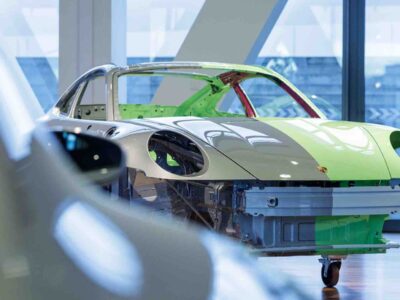In 1492, Columbus sailed the ocean blue, using sailboats. But you know that; it’s one of the first things you learn in elementary social studies class. Wind used to be the only fuel source to cross the oceans that divided the continents.
Today, sailboats are a relic of a past life, or are they? Oceanbird, a Sweden-based marine manufacturer, is bringing back wind-powered vessels. It’s a strategic attempt between shipping companies Alfa Laval and Wallenius to get cargo carriers off the fossil fuel standard and embrace more renewable power.
How can Oceanbird build a wind-powered vessel in 2023? How is that even efficient for travel? These are all valid questions, but Oceanbird has an answer.
The plan is to build a 40-meter-wide, 220-meter-long wingsail. The sail and mast are made from recycled PET materials and glass fiber, with each sail weighing around 200 metric tons. Inside, the core and a flap draw in air that propels the boat with wind gusts. The sails can contract to half their width and can be tilted flat to the deck to avoid bridges.
The propulsion system is found in high-performance racing yachts. Vessels can travel faster than the speed of wind by using the gusts as the primary power source. According to the company, up to 90% of conventional shipping emissions could be eliminated. This summer, Oceanbird will test the wingsail on a 14-year-old car carrier, the Wallenius Tirranna.

Photo Courtesy Oceanbird
Oceanbird says their researchers are putting the wingsails through difficult testing to ensure the durability was up to par. Burn tests were used to verify the sail’s quality and weight. Annika Edström, the lead mechanical engineer at Oceanbird, headed up the research.
“So far, we have mostly verified our material choices and validated our structural calculations,” Edström said. “We have also compared different design set-ups to transfer loads from our composite to the rest of our steel structure, which has actually resulted in a more lightweight design.”
In addition to testing the wingsail on the Wallenius Tirranna, parent company Wallenius Wilhelmsen intends to order the first novel Oceanbird-infused vessel, the Orcelle Wind.
It won’t set sail until early 2027, a few years away. However, the project is gaining serious attention from the Norwegian government and top companies like Volvo, BMW, and Mercedes-Benz.
According to Oceanbird, retrofitting an existing ship with a single wingsail reduces fuel consumption by 10%, but on their own, they can reach up to 60% reduction. It reaches 90% if speed compromises and ships take specific routes.
Oceanbird’s technology is a potential solution to the transoceanic shipping emission problem. The International Maritime Organization (IMO) reports that shipping accounts for 3% of all carbon emissions. That seems low, but the carbon intensity of shipping emissions is the problem.

Photo Courtesy Oceanbird
Despite improvements, carbon intensity has fluctuated. The IMO wants to reduce “greenhouse gas emissions from international shipping by at least half by 2050, compared with their level in 2008.” More regulations were implemented to limit emissions, fuel consumption, and carbon intensity, but changing a ship’s power source is the most effective way to reach this goal.
Oceanbird offers another solution, joining other shipping lines that are developing hydrogen propulsion, biofuels, solar-powered engines, and battery-powered boats.
As more testing occurs, there will be a concerted effort to ensure renewables can carry ships across the globe without issue.
“Wind is an opportunity we must seize now. There’s simply no time to waste in phasing out fossil fuels,” said Niclas Dahl, managing director of Oceanbird.
However, wingsail ships have their limitations. They won’t be able to cross the Panama or Suez Canal due to restrictions on wind-powered crossings imposed by the canals’ authorities and height limitations, especially at the Panama Canal. Container ships also are unlikely to use them due to limited deck space. This issue is another reason the Orcelle Wind will be roll-on, roll-off car carrier. It can store cars in the cargo hold and doesn’t need cranes to unload.
According to WIRED, about 25 wind-powered cargo ships are in operation today. Most use a type of sail associated with traditional versions. Some use composite cylinders that rotate fast to generate acceleration. There are also suction wings or turbosails, the tech developed by Jacques Cousteau, that use fans to create suction. Some even have giant kites that float 200 meters above the ship.
Wind power boats certainly aren’t a dead concept. They’re making a comeback in the wake of these emission-reduction missions.





